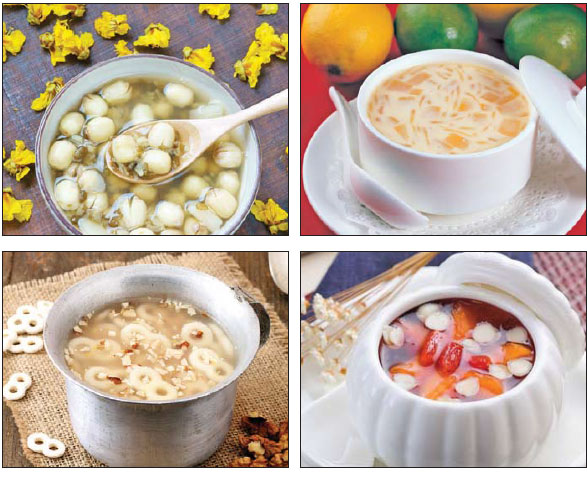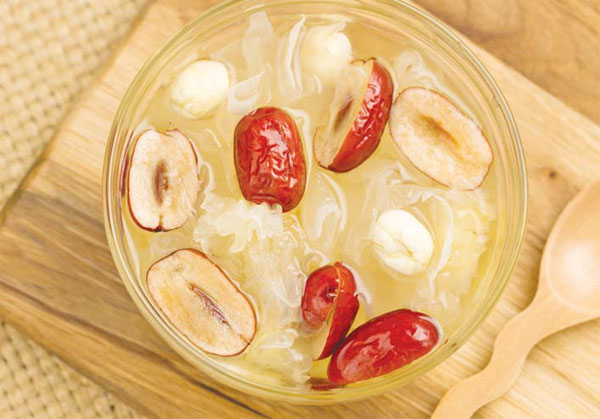Sweet coolers for summer heat

Editor's note: To understand China, sit down to eat. Food is the indestructible bond that holds the whole social fabric together and it is also one of the last strong visages of community and culture.
Growing up with a pair of grandfathers who loved to eat had its advantages. I was always fed the best bits from their bowls, and when they had special treats delivered to the house they would holler and I would scamper as quickly as I could to answer their calls.
They were as different as could be. My mother's father was a self-made man, a dockworker who built his fortune running a fleet of bumboats, which were small cargo boats, when Singapore still needed bumboats on the river.

| In the hot and humid weather, a refreshing bowl of sweet soup can whet flagging appetites. Photos Provided to China Daily |
My paternal grandfather was a stern scholarly merchant who retired early from business and spent the rest of his life on culinary pursuits. They both had a sweet tooth.
Their common love for sweet things was manifested in many suppers that consisted of mainly sweet soups - a particular style of cooking desserts that originated primarily from South China.
Most folks from Fujian province, like my maternal grandpa, grew up eating a lot of sweet potatoes. The land was poor and mountainous and rice was a luxury while sweet potatoes could grow in rocky nooks and crannies.
Even congee, cooked in plenty of water, often had large pieces of sweet potato added as fillers.
Perhaps it was because he missed home, but grandpa's favorite sweet soup was sweet potatoes in rock sugar syrup, flavored with large pieces of ginger. In addition to giving the syrup a pleasant bite, the sharpness of the ginger also prevented flatulence.
In the hot and humid weather, a refreshing bowl of sweet soup whetted flagging appetites.
But when it comes to cooking sweet soups, no one beats the Cantonese. In Hong Kong, Guangzhou and even the Guangxi Zhuang autonomous region, night birds on the prowl in summer stop by specialized dessert shops selling sweet soups.
The menu can be impressively long.
It could be a sweet soup of double-boiled papaya with snow fungus and crushed fritillary bulbs, or a red-bean soup boiled long and slow so all the beans would have dissolved. Even the aged citrus peel used to flavor the dessert would have disappeared in the long cooking. Some chefs even sieve the soup before serving, removing the bean skins. The result is a bowl of velvety deliciousness.
Fritillary bulbs? Citrus peel? That's right. These ingredients are added because the Cantonese chef firmly believes that food is medicine, and even that decadent bowl of sweet stuff must have some health benefits.
Fritillary bulbs are known to cure coughs and chronic inflammation of the bronchial tubes, and so are meant to sooth those nasty summer coughs and colds. Citrus peel, aged 10 years or more, is also good for the throat.
Mung beans are slow-cooked as a sweet soup, as well. Pieces of dried kelp are added to the soup and there is also a pungent herb that traditional cooks add. I never could find the name, since it's simply known as choucao, or stinky grass.
Smooth velvety congee-like soups can also be made from powdered peanuts, sweet almonds, walnuts and black sesame. Finely ground rice flour is added to thicken the concoctions.
A piping hot bowl of sesame paste is a comforting supper. In Hong Kong, some shops offer you a yuanyang, or paired option, in which you can have two choices in the same bowl. My favorite was always half nutty black sesame paste and half sweet white almond paste.
There are also the famous milky custards from my grandfather's hometown, Daliang in Shunde county, Guangdong province. Here, rich water buffalo milk is mixed with ginger juice so it miraculously becomes a soft sweet curd.
The same milk is steamed twice. Once to create a chewy skin, and then beaten egg white is added so the milk turns into a soft, white custard in the second steaming. Most dessert shops also offer the golden custard, made with whole eggs.
Barley water may be the bane of some Western children, but barley water brewed the Chinese way is both delicious and nutritious.
Pearl barley is boiled with ginkgo nuts and dried bean curd sticks to produce a smooth, milky sweet soup. It is a popular homemade concoction for hot summer days and eagerly drunk by the entire family, young and old.
Sometimes, if the cook is feeling generous, whole eggs are dropped into the boiling broth to poach.
That's not to say sweet soups are a Cantonese prerogative.
In the beautiful lake districts of Hangzhou, Suzhou and Yangzhou, they fill little glutinous rice balls with sweet fillings like red bean or sesame paste and cook them in a sweet soup flavored by half-fermented rice, the byproduct of making rice wine.
This is an especially festive dish, served at birthdays, weddings and on major festivals.
Of course, Chinese chefs are always on the lookout for new recipes, and one extremely popular sweet soup these days is the beautifully named heavenly ambrosia, yangzhi ganlu.
Its ingredients reflect a departure from tradition, with imported and rare ingredients like mango, grapefruit and sago.
You can hardly eat a wedding banquet these days without finishing the meal with this colorful, sweet soup, considered both delicious and auspicious.
For many Chinese, sugar is still a rare treat, and the luxury of making and having dessert is an indulgence. In summer, especially, a bowl of sweet soup with all its curative properties is simply love in a bowl, to be slowly savored and enjoyed.
paulined@chinadaily.com.cn
Two dishes to try
Sweet almond paste
This is especially popular in summer as almonds are considered good for the lungs and may act as protection against summer sniffles.
209 g almonds, soaked and skinned
50 g white rice, soaked for at least four hours
Rock sugar to taste
Water
Rub skins off almonds and place nuts and drained soaked rice in a food processor. Add enough water to pulverize the nuts and rice as fine as you can.
For the desired smoothness, filter the mixture through fine muslin.
Place filtered solution in pot and start cooking, stirring as mixture thickens, adding water till you get desired consistency.
Add rock sugar to taste. Best served hot.
Pearl barley with gingko nuts
My childhood favorite. The best thing about eating this is hunting for golden gingko nuts hiding among the barley grains. This is slightly diuretic and also good for constipation.
100 g pearl barley
100 g gingko nuts, shelled and skinned
Two long pieces of dried bean curd sticks, soaked till soft
Rock sugar to taste
Wash pearl barley to remove excess starch. Place in pot of water and start boiling. Add gingko nuts and cook until barley grains flower.
Add broken up bean curd sticks. Depending on quality, bean curd sticks may dissolve and disappear, coloring soup milky white. That's good, don't worry.
When sweet broth is slightly thick, add rock sugar to taste. Serve hot. Any extra can be kept in fridge and served cold. Equally yummy.
(China Daily European Weekly 05/27/2016 page21)
Today's Top News
- Takaichi must stop rubbing salt in wounds, retract Taiwan remarks
- Millions vie for civil service jobs
- Chinese landmark trade corridor handles over 5m TEUs
- China holds first national civil service exam since raising eligibility age cap
- Xi's article on CPC self-reform to be published
- Xi stresses improving long-term mechanisms for cyberspace governance































